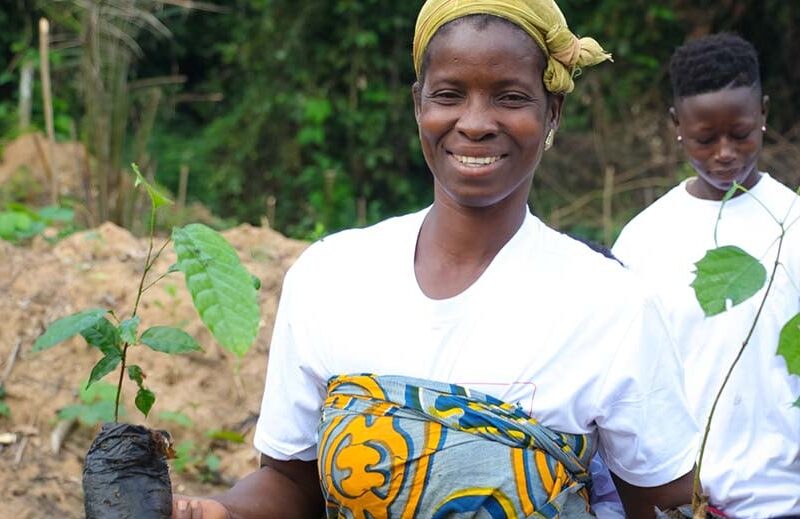Nestlé partners with Cargill for net zero 2050 agroforestry scheme for cocoa communities

pic: Nestle
Nestlé has launched a key environmental performance improvement drive, delivering two new products devised with suppliers Cargill and export project development group ETG | Beyond Beans, as part of net zero 2050 commitments, writes Neill Barston.
As the company revealed, the latest five-year initiative is tasked with reducing and removing carbon emissions from its supply chains, through implementing agroforestry and regenerative agriculture within core cocoa communities.
According to the Swiss-headquartered group, the scheme will involve planting multi-purpose species of shade trees will be distributed to farmers, who will learn tree planting and pruning. Shade trees are used to help reduce the harsh effects of the sun and provide moisture-rich spaces for cocoa crops to survive during the dry season. They can also improve water management and enhance on-farm biodiversity, as well as absorbing carbon from the atmosphere.
Among the core goals of the scheme will be be plant over two million shade trees on land managed by close to 20 000 farmers in Ghana and Ivory Coast. Together, the projects are estimated to deliver a reduction and removal of over 500 000 metric tonnes of carbon over a 20-year period.
As for the pace of transformation, the company added that its aims to reduce its green house gas emissions by 20% against its 2018 figures by 2025, and by 50% in the next six years. Last year, it delivered a 13.58% net reduction in emissions.
“These projects are important milestones on our journey to net zero. We’re working to address our emissions all the way to the farms we source from,” said Darrell High, Global Cocoa Manager at Nestlé. “Long-lasting forest protection can only happen when collaborating with fully committed suppliers, just like Cargill and ETG | Beyond Beans. We also depend on the participation of local communities, who have an impact on the forests and can help find land-use solutions that are best suited for the local reality.”
Close collaboration with local communities is a key aspect of the projects. Their involvement includes selecting community-owned fallow land for reforestation work and starting with the establishment of tree nurseries. These nurseries produce and grow seedlings for later transplantation on-farm. Participating farmers will sign up on a voluntary basis and should already be part of the Nestlé Cocoa Plan.
The survival rate of the trees is also an important success factor. Farmers will receive an incentive payment when they plant the tree seedlings and care for them during the critical initial years. Regular farm visits will also be performed to monitor and provide advice and technical assistance where needed.
“We are proud to partner with Nestlé on this ground-breaking carbon reduction project that transitions away from business as usual,” said Remi van Balen, Programme Manager Agroforestry and Environment, ETG | Beyond Beans. “Our project design has a holistic landscape approach which goes beyond cocoa plots and involves the whole community in reforestation initiatives. These initiatives not only create job opportunities but are also connecting, restoring and protecting valuable community forests.”
“This initiative can really make a difference,” said Ursule Gatta, Cargill Partnership Officer Ivory Coast. “Our ambition is to scale up the project to cover 18 cooperatives over five years, aligned with the Nestlé Income Accelerator program. We are very proud to be a part of this.” As the company noted, Both ETG | Beyond Beans and Cargill also support the implementation of Nestlé’s Income Accelerator Programme, designed to help move farmers towards earning a living income.
As the business added, monitoring and verification is critical for ensuring long-term success. Each project is set up with a monitoring plan that covers the project’s lifetime, which will track both the number of trees and the corresponding tonnes of carbon dioxide sequestered.
This will help ensure verifiable and permanent carbon removals within Nestlé’s supply chain. Non-carbon benefits generated from the projects, such as the impact, appropriateness, effectiveness and efficiency of reforestation and natural landscape restoration initiatives, will also be monitored. High-resolution images from satellite monitoring will be used to help ensure that the trees planted continue to thrive over the long term.
In terms of environmental statistics, the company noted that forests can absorb approximately 2.6 billion tonnes of carbon dioxide every year. This is the equivalent to one third of the CO2 released from burning fossil fuels. More than two-thirds of Nestlé’s GHG emissions come from sourcing its ingredients, Nestlé has committed to planting and growing 200 million trees in the regions it sources from globally by 2030.
